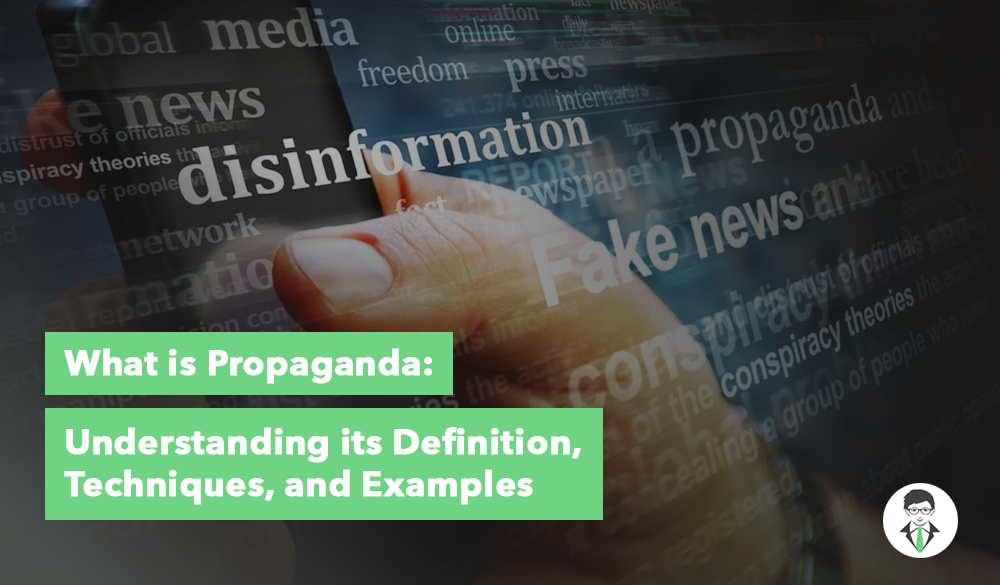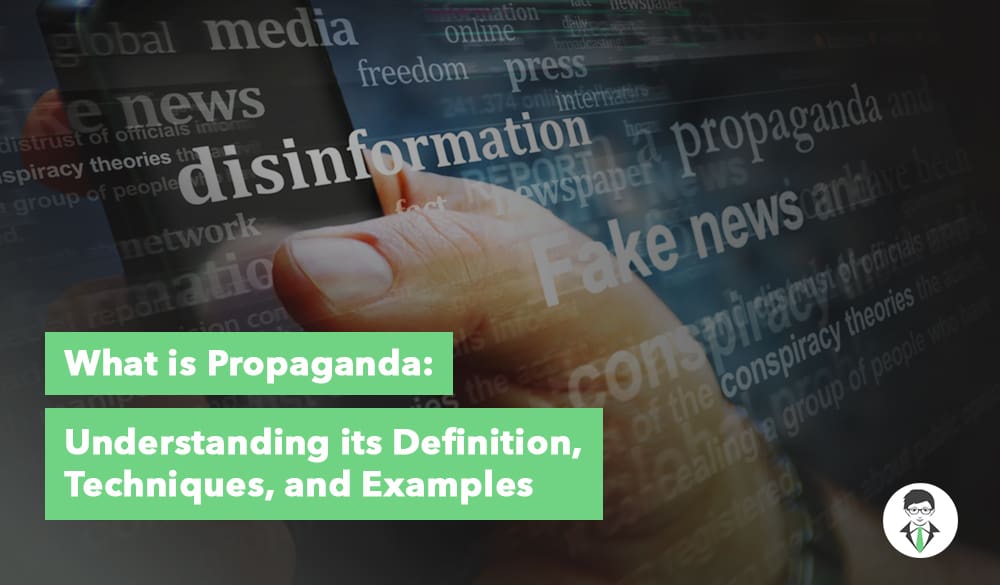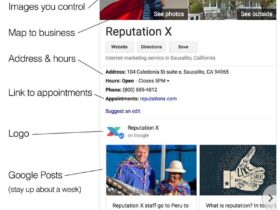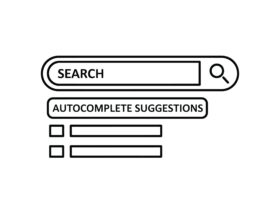Propaganda, a term often associated with persuasion and manipulation, is significant in shaping opinions and influencing behaviors in various contexts. Understanding the definition, techniques, and examples of propaganda can shed light on its impact and ethics.
The term ‘propaganda’ has its roots in the ‘Congregatio de Propaganda Fide,’ a missionary organization established by the Roman Catholic Church under Pope Gregory XV in 1622 to oversee foreign missions and propagate the faith. This historical context highlights the evolution of propaganda from religious missions to its modern forms in political and psychological contexts.
Propaganda can be defined as the deliberate and systematic dissemination of information, ideas, or rumors to influence public opinion and shape beliefs. It is designed to manipulate people, emotions, attitudes, and behaviors by presenting information in a biased or one-sided manner.
There are different types of propaganda, each employing unique strategies to achieve its goals. Some of the commonly recognized types include political propaganda, war propaganda, religious propaganda, and advertising propaganda.
Techniques used in propaganda leverage psychological tactics to appeal to emotions and influence perception. These techniques include bandwagon, fearmongering, name-calling, testimonials, transfer, and loaded language. By employing these techniques, propagandists can effectively sway public opinion and promote their intended message.
Examples of propaganda can be found throughout history and encompass various contexts. World War II propaganda, Cold War propaganda, political campaign propaganda, and advertising propaganda are some instances where propaganda has been employed to sway opinions, manipulate perceptions, and rally support. Studying these examples offers insights into the strategies and tactics employed by propagandists in different situations.
Understanding the impact and ethics of propaganda is crucial. While propaganda can be a powerful tool for persuasion, it raises questions about the manipulation of information and the ethics of influencing public opinion. By critically examining and evaluating propaganda, individuals can develop a greater awareness of its influence and make informed decisions about the messages they encounter.
Definition and Types of Propaganda
Propaganda is a term that stirs curiosity and intrigue. In this section, we uncover the essence of propaganda, exploring its definition and types. Black propaganda is characterized by its misleading or falsified nature, often from unidentified sources with malign intent. Political campaigns often employ political propaganda to sway public opinion toward specific candidates or issues. Dive into the world of persuasive messaging, where manipulation and influence shape opinions. Discover the basic elements that define propaganda, and get a glimpse of the different types that exist. Prepare to be enlightened as we unravel the power and tactics behind this pervasive communication tool.
Definition and Basic Elements of Propaganda
Propaganda is a powerful tool for manipulating people’s beliefs and behaviors. It is essential to understand its definition and basic elements to recognize its influence. Propaganda deliberately disseminates information or ideas to mold public opinion and influence individuals toward a particular belief or action.
- Message: Propaganda presents a carefully crafted message that promotes a specific viewpoint or agenda. The message is designed to persuade and manipulate the audience.
- Propagandist: A propagandist is the person or group responsible for creating and disseminating propaganda. They use various tactics to convey their message effectively.
- Target audience: Propaganda is crafted to target specific groups or individuals more likely to be influenced by the message. Understanding the audience helps the propagandist tailor their tactics accordingly.
- Techniques: Propaganda employs different techniques to appeal to the audience’s emotions, biases, and subconscious desires. These techniques include fearmongering, name-calling, testimonials, and loaded language.
- Purpose: Propaganda serves a purpose, whether it is to gain support for a political ideology, promote a product, or shape public opinion. It aims to influence thoughts and actions in favor of the propagandist’s objectives. Scholarly works published by Princeton University Press provide in-depth analyses of these elements, affirming their significant contribution to communication and persuasive discourse.
Types of Political Propaganda
Various types of propaganda are used to influence and manipulate public opinion. War propaganda is often used to bolster public support for the war effort and to undermine support for the enemy. Governments, organizations, and advertisers often employ these techniques, including bandwagon, fearmongering, name-calling, testimonials, transfer, and loaded language.
It’s important to critically evaluate the information presented and consider the underlying motives and biases when analyzing propaganda. By understanding these propaganda techniques, you can better identify and resist manipulation. Additionally, various methods are used to spread propaganda, highlighting techniques such as social media campaigns, fake news dissemination, and targeted advertising.
Techniques Used in Propaganda
Discover the art of persuasion as we delve into the techniques used in propaganda. From the persuasive power of bandwagoning to the manipulation of fearmongering, name-calling, testimonials, transfer, and loaded language, each sub-section will unveil the tactics employed to influence minds. Brace yourself for a fascinating dive into the world of propaganda, where language, emotion, and persuasion intertwine to shape opinions and beliefs.
Bandwagon
The Bandwagon technique is a persuasive tactic that taps into our natural desire to fit in and be part of what’s popular. It promotes an idea or product by emphasizing how widely accepted or supported by the majority, creating a subtle pressure to join in. This approach suggests that going against the crowd might not be the best choice, encouraging people to follow the trend to avoid feeling left out.
Fearmongering and Psychological Warfare
Fearmongering is often used in propaganda to affect people’s emotions. It involves spreading exaggerated or misleading information to create fear or anxiety, pushing the audience to act out of a sense of urgency or danger. Politicians, advertisers, and media outlets frequently use this approach to shape public opinion or promote certain products.
When faced with fearmongering, it’s important to question the source of the information and look into the facts yourself. Considering different perspectives and seeking out balanced sources can help you avoid falling into emotional manipulation. Take a moment to think critically about the motives behind these tactics before forming opinions or making decisions. Staying informed and engaging in open, honest conversations can help challenge fear-based narratives.
Name-calling
Name-calling is a propaganda tactic used to discredit individuals or groups by labeling them with negative terms. It aims to manipulate public perception by evoking strong emotional reactions and reinforcing existing biases. This technique is often seen in political campaigns, where candidates use insults to undermine opponents. Recognizing name-calling for what it is helps you critically evaluate the information and avoid being swayed by manipulative tactics, allowing for more informed and thoughtful decision-making.
Testimonials
Testimonials are a powerful tool in propaganda, used to provide social proof and sway public opinion by showcasing personal endorsements. These endorsements often come from individuals who claim to have had positive experiences with a product, service, or idea, and propagandists strategically choose people who are respected or admired to boost credibility.
Testimonials create an emotional connection, often through relatable success stories or transformations, which can be particularly persuasive in advertising. They’re commonly used in campaigns for everything from political figures to healthcare products, aiming to influence attitudes and behaviors by tapping into the persuasive power of personal experiences. It’s important to critically assess testimonials, considering their credibility and potential biases, and to distinguish between objective facts and subjective opinions.
Transfer
Transfer is a common propaganda technique that creates associations between a person, idea, or product and something already perceived positively or negatively. By connecting the subject to something well-liked, such as a celebrity or admired values, advertisers and political campaigns try to influence public opinion.
For instance, a political ad might show a candidate with a respected community leader, hoping that the positive qualities of that leader will rub off on the candidate. Conversely, transfer can be used negatively, linking an opponent to unpopular figures or ideas to stir up disapproval. The goal is to shape emotions and sway opinions, so it’s important to recognize when this tactic is used and think critically about the presented message.
Loaded Language
Loaded language is a powerful tool utilized in propaganda to evoke intense emotional reactions from the audience. This technique subtly includes words or phrases with strong connotations or emotional weight. Employing loaded language aims to manipulate how the audience perceives a specific subject or matter. This tactic can create a positive or negative connection with a particular concept, person, or group. Examples of loaded language include terms like “innocent,” “evil,” “tyrant,” “freedom fighter,” or “traitor.”
Through the adroit use of loaded language, propagandists can sway the thoughts and opinions of the audience without presenting objective facts. The influence of loaded language is prevalent in diverse forms of propaganda, such as political campaigns, advertising, and mass media for manipulation. Therefore, individuals must be aware of this technique to avoid solely being influenced by emotional appeals rather than engaging in rational analysis.
Examples of Propaganda
Propaganda has long been used to shape public opinion and behavior, from World War II and the Cold War to modern political campaigns and advertising. During World War II, governments used posters, films, and broadcasts to rally support, portraying enemies as evil and stirring patriotism and fear. The Cold War saw similar tactics, with the U.S. and Soviet Union using fearmongering, name-calling, and symbolism to heighten tensions and sway public opinion. Publications from Manchester University Press offer significant historical texts that analyze the nature and impact of propaganda in society.
In political campaigns, propaganda manipulates voters through emotional appeals, demonizing opponents, and using testimonials. These techniques create connections with voters and reinforce narratives through repetition. Advertising propaganda works the same way, using celebrity endorsements, emotional appeals, and testimonials to convince consumers they need certain products.
Recognizing these tactics helps us critically evaluate the messages we receive and make more informed decisions, whether in politics, advertising, or broader societal contexts.
The Impact and Ethics of Propaganda
Propaganda is crucial in shaping individuals and society, presenting ethical concerns. It exerts influence over public opinion, molds beliefs, and manipulates emotions. The strategies employed in most propaganda and campaigns aim to sway the masses without offering balanced perspectives. This lack of objectivity undermines critical thinking and can result in the spread of misinformation. The dissemination of biased information can lead to polarization, mistrust, and divisions within communities.
To evaluate the effects of propaganda, it is important to analyze the motivations behind its dissemination and the potential consequences for society. Ethical considerations arise when propaganda is utilized to manipulate public opinion, suppress dissenting voices, or endorse harmful ideologies. Safeguarding democratic principles, freedom of speech, and access to unbiased information is crucial.
Media literacy and critical thinking skills are indispensable to counteract the negative impact of propaganda. By promoting media literacy education, individuals can learn to identify propaganda techniques, assess the credibility of sources, and make informed decisions. Furthermore, advocating for ethical practices within the media industry can help rebuild public relations trust and ensure responsible information dissemination.
Understanding the impact and ethics of propaganda is vital for maintaining a healthy and democratic society. By being aware of the techniques employed and actively promoting ethical practices, individuals can adeptly navigate the intricate landscape of information and safeguard the integrity of public discourse.
















